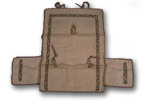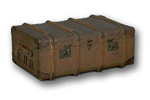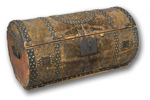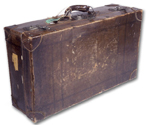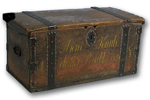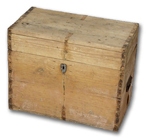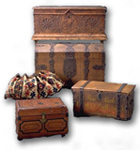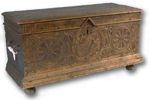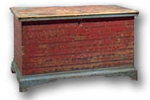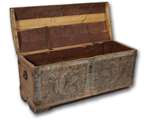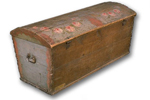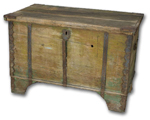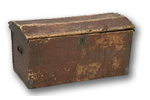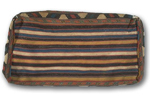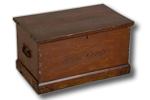|
|
|||||||||||||||||||||
Trunks and TravelIn the past 400 years, millions of immigrants have arrived on Canada's shores. Motivated by the desire to better their lives and those of their children, they left their homelands having packed their essential belongings in bags and baggage of all kinds and sizes: suitcases, leather satchels, wicker baskets and hampers, duffel bags, trunks, wooden chests, cloth bundles, cardboard boxes, and crates. Some containers were so fragile or modest that they were discarded soon after arrival. Others have not only survived as tangible reminders of a courageous decision to make a new life in Canada but, as in the case of wooden chests brought by some ethnic groups, have also served as the inspiration for local furniture making and decoration. The size and character of immigration flows to Canada have changed considerably since the beginning of permanent settlement in 1608. During the period of New France up to 1760, approximately 10,000 French subjects settled in what are now Quebec and the Maritime provinces. The next significant wave of immigrants came in the decades following the American War of Independence when some 50,000 British Loyalists left the United States and established themselves in eastern Canada. Transatlantic immigration began in earnest after the Napoleonic Wars ended in 1815 and during the next half century brought about one million people, principally from the United Kingdom. From Confederation to 1970, 10 million people settled in Canada. Those of British origin predominated but increasingly migrants came from central, eastern and southern Europe, and to a much lesser extent from Asia. While many of these immigrants came directly to Canada, others first passed through the United States. Although the precise reasons for emigrating from one's homeland varied from person to person, some of the underlying causes fall into broad patterns. Poor economic prospects in the home country arising from a shortage of farmland or employment opportunities, an oppressive or unstable political situation, religious discrimination, dislocations caused by war, compulsory military service, and appeals to join relatives and friends in a new land were some of the major factors that contributed to the decision to leave. Improvements in transportation, notably an increasingly dense network of railroads in Europe by the end of the 19th century, meant that migrants could more easily reach a port of embarkation. In addition, after 1850 the replacement of sailing ships by steamships meant that the voyage across the Atlantic was no longer a daunting experience. Where a sailing ship took four to six weeks to make the crossing, one powered by steam initially required only 10 to 12 days; by 1900, faster and bigger ships further cut the time by nearly half. The circumstances leading to departure were important in determining what possessions travellers brought with them. While both men and women migrated as individuals, men often led the migration process, either because they moved with the intention of working for a few years before returning home, or because they needed to establish themselves and earn enough money to allow their families to follow. In both instances, migrants were likely to travel 'light', carrying their clothing and necessary belongings in a small bag or trunk. One type of small chest, dating to the 17th and 18th centuries, was cylindrical in shape so that it could be easily carried beneath the arm. Although men frequently preceded women among most nationalities migrating to Canada in the latter part of the 19th century and during the first decades of the 20th, for no group was this more evident than the Chinese. Chinese men who came to Canada to work on the construction of the Canadian Pacific Railway and in resource industries could not afford to bring wives or brides to Canada after the Canadian government imposed a tax on Chinese immigrants; initially set at $50 per head, it was raised to $100 in 1901 and then to $500 in 1903. As a result, in 1911 the Canadian census recorded 28 Chinese males for every Chinese female, a ratio that far surpassed the overall proportion of 158 immigrant men to 100 immigrant women. When it came time for families to join their menfolk, or when families migrated as a unit, the packing of household effects was more elaborate, involving careful choices of what to take and what to leave behind. Clothing, linens, valuables, kitchen utensils, small tools, and family mementos were kept while furniture and other bulky items were sold. Of course, if a family had few possessions to begin with, all but the bare essentials might be disposed of so as to pay their passage. To ship their effects, many migrants relied on trunks and chests. Trunks differed from chests in that they were expressly designed for transporting goods. Utilitarian rather than decorative, trunks shared a number of elements regardless of their origins and size. Topped with a flat or domed lid, they were generally of a sturdy wood construction reinforced with metal corners and strapping. In the 18th and first half of the 19th centuries it was not unusual for trunks to be covered with hide or fibre, but by the end of the 19th century canvas held by wood strips, or painted sheet metal, was commonly applied over a wooden box. By 1900, some trunks were made entirely of sheet metal. For ease of handling, trunks were furnished with handles that before about 1870 were fashioned from iron and thereafter from a variety of materials including leather. Given that a packed trunk stored valuable possessions and was often consigned to the care of others on long trips, a dependable lock was also an important feature. Where trunks were strictly functional, the wooden chests used by immigrants before the end of the 19th century embodied decorative elements that drew on well-established craft and ethnic traditions in their native lands. In fact, prior to transporting migrants' possessions, these chests may already have served as important articles of furniture, storing clothing, bedding or even the dowry for a future household. Commonly built using either a frame-and-panel construction or a simpler "six board" type with the pieces being nailed together or attached with dovetail or rabbeted joints, these chests were frequently raised off the floor by feet or a base. The brass and iron hardware – keyhole escutcheons, handles, hinges, and bindings – could be quite elaborate, contributing to the overall appearance of the chest. What gave many wooden chests a distinctive appearance were the decorative motifs painted or, more rarely, carved on the top and sides. These decorations included floral and animal motifs, geometric designs, and religious symbols, all combined in a folk art that could be quite unique to an ethnic group. Icelandic and Scandinavian chests featured the flowing lines and delicate floral designs known as rosemaling. Ukrainian chests were brightly decorated with a combination of geometric shapes – circles, pinwheels, squares, and triangles – and floral motifs. Polish immigrants from the Kashuby district (the Vistula river delta) frequently employed flower-in-vase designs and geometric forms, while Germans painted tulips and pairs of birds. One type of chest, the dower or hope chest, might bear either a female name or the initials of the betrothed couple, together with a heart and other decorations. Trunks and chests continued to be useful after their owners arrived in Canada, not least because they may have been the only furniture new immigrants possessed. As large, sealed containers, they were ideal for safely storing household effects in the same way they had been used in the home country. Flat-topped versions also served as tables and, as various worn and bent lids suggest, as seats. To make their chests more comfortable in this latter role, Doukhobor settlers, and no doubt others, made rug-like coverings. The painted chest, besides its practical uses, also served as an important symbolic reminder of an immigrant's ethnic and religious roots. Barnardo ChildrenIn the period from 1869 to 1924, British charitable agencies sent more than 80,000 children to live in rural Canada, with most arriving in the years between 1880 and 1914. Among the approximately fifty agencies involved in this work, the largest was Barnardo's Homes, under whose care nearly one-third of the children came to Canada. Assisted emigration was not unusual in the 19th and early 20th centuries, but what made this movement unique was that it involved large numbers of boys and girls, from toddlers to adolescents, who were all unaccompanied by their parents even though only one-third of them were orphans. Moreover, once in Canada, the children were not adopted into new families, but rather were taken into households to be trained and to work as agricultural labourers and domestic servants. What were the circumstances behind the migration of these 'home children'? During the last half of the 19th century, middle-class reformers in Britain became increasingly worried by the plight of the labouring poor who lived in the slums of their country's largest industrial cities. From the 1860s, unemployment and the shortage of affordable housing created overcrowded conditions where poverty, hunger, filth, and disease spread unchecked. In the views of reformers, this situation was creating a growing population of poor who were coarse, drunken, and immoral. Children raised in this environment, having limited access to schooling and being obliged to take on domestic chores and even work outside the home from a young age, were considered at great risk of falling into the same ways. Faced with the growing crisis among the poor, social reformers turned to different solutions. Child emigration appeared to have a number of advantages. It was seen as a means of relieving British cities of young paupers who might turn to crime or be a future burden on society. Settlement in a new land, preferably in a rural setting, would allow children to acquire respectable habits of honesty, thrift and hard work, and to grow up away from the harsh life of urban slums. Emigration was also an economical alternative to maintaining children in an institution until they were old enough to work. Although the cost of sending a child to Canada equalled about one year of institutional care, about £10 to £15, where a young child was involved that expense would be more than offset by several years of savings. In addition, the Canadian government and some shipping companies, interested in promoting settlement, made emigration attractive by offering various subsidies. Although tentative experiments with child emigration date as early as the 1830s, interest in rescue projects of this nature did not become sustained until after 1869. But this work also raised controversy. Sensational stories about isolated incidents of criminal and immoral behaviour committed by home children raised Canadians' fears about the character of the young emigrants. More importantly, the poor choice of placements in Canada and the subsequent lack of supervision left children vulnerable to being exploited and abused. The rescue agencies tried to allay both sets of concerns but, as well-intentioned and careful as they may have been, they never adequately took into consideration the welfare and safety of the children in their charge. One reformer who was inspired by the work of the child emigration pioneers but believed he could do it better, was Thomas Barnardo. Armed with religious zeal and intent on saving children from the degradation and misery of London's slums, from the late 1860s he established rescue homes in London and in the British countryside which took in hundreds of young paupers. Unwilling to turn away needy children but recognizing that new admissions were limited by the capacity of his homes, Barnardo became a champion of child emigration from the early 1880s. When soliciting financial and political support for his homes and child emigration, Barnardo appealed to Victorian sympathies by emphasizing the most distressing cases of neglected, abused, homeless and underfed children. However, that public picture of the rescue child presented a partial description of the circumstances that brought a youngster into Barnardo's care, a distorted view that would leave an enduring stigma on many children. In reality, most emigrant children came from respectable, if poor, families bound by strong ties of affection and support. These children were brought to institutions such as Barnardo's as a last resort, when a crisis, or repeated crises – desertion or death of a parent, illness, unemployment – prevented a family and its network of kin from coping. Although some families regarded admission as a temporary expedient, the rescue homes carefully controlled or even discouraged further contact between all children and their relatives for fear that the children would be tempted to return to their former lives. When child-savers judged families to be disreputable or immoral, they took special precautions to insulate their charges from bad influences, going so far as to notify relatives about the emigration of their children only after the sailing date, if at all, and holding back correspondence. Children making the voyage across the Atlantic were equipped with new clothing that was both appropriate for Canada's different seasons and practical for life on a farm. All children received a winter coat, boots, shoes, a cap or hat, a jacket or sweater, underwear and toiletries. In addition, boys were provided with a suit, a few shirts, two ties, and a couple of pairs of work trousers or overalls, while girls were issued six to eight dresses, six aprons, petticoats for summer and winter, and stockings. To encourage children to follow the correct moral path when in their new homes, they also received uplifting books that included a Bible, a marked New Testament, a hymn book, and John Bunyan's The Pilgrim's Progress. Lastly, the outfit included instructions on how children should behave in their placements, and stationery so they could remain in contact with the home. These belongings, together with the few trinkets or keepsakes a child might have, were packed in a single trunk. The Bernardo Technical School in England manufactured a model made of hardwood and covered in imitation alligator skin that was used extensively. Other types of chests, such as the wooden and sheet metal ones pictured here, were also used. The Barnardo children arrived by ship at Halifax, Quebec City, or Montreal and then travelled by train to one of the receiving homes Barnardo had established in Toronto, Peterborough, and Russell, Manitoba. From this temporary residence, children were collected by employers or were sent out by train or carriage to a family living in a more remote community. The placements with Canadian families were regulated by formal contracts or indentures that clearly set out the responsibilities of the rescue home, the child, the master, and the mistress. For a youngster under the age of ten, the master or mistress received $5 a month from the agency for lodging, feeding, schooling and clothing the child, who was expected to do minor chores around the house and farm. Between 11 and 14, children received only their board, clothing and some schooling in exchange for their labour. From 14 to the end of the indenture at aged 18, the children were expected to perform adult's work on a full-time basis, and thus were entitled to wages. Barnardo youths received their pay, amounting to $100 to $200, at their indenture's end. The nature of the placement system, by which Canadian households gained different benefits according to the age of the emigrant children, contributed to the vulnerability, loneliness, and suffering of the children. The youngest children were generally placed in newly settled areas where households welcomed the monthly $5 boarding allowance. Farm life on the frontier was never easy, and the transition was particularly difficult for children with no previous experience of farming. Despite Barnardo's promises of regular inspections, the remoteness of these locations meant that the most vulnerable children were supervised the least. As children matured and were able to contribute more, their labour came more in demand in more prosperous agricultural districts. Consequently, Barnardo boys moved an average of three times during their first five years in Canada, girls an average of four times. Growing up in several households and always expected to work hard, the children often remained outsiders who were never fully welcomed into a family or a community. Despite the hardships the emigrant children encountered, most adapted to Canadian life and remained in Canada. Many of the women, once their indentures were over, settled in larger cities, taking up jobs in domestic service, factories or stores. While some of the men remained on the land as agricultural labourers and independent farmers, many more migrated to the cities to become factory workers, artisans and clerks. In this respect, the goal of the child-savers to have their charges grow up and settle in rural Canada was only partially met. The efforts of the rescue agencies were further confounded by the child emigrants – about one-sixth of the Barnardo children – who, as adults, permanently returned to Britain. Suggested readings for "Trunks and travel" For an overview of immigration to Canada, see the three volumes of the Historical Atlas of Canada, as well as Monica Boyd and Michael Vickers, "100 Years of immigration in Canada", Canadian Social Trends, (Autumn 2000), pp. 2-12. Immigration policy is explored by Valerie Knowles, Strangers at Our Gates: Canadian Immigration and Immigration Policy, 1540-1997, (Toronto: Dundurn Press, 1997), and briefly by Reg Whitaker, Canadian Immigration Policy since Confederation, Canadian Historical Association, Canada's Ethnic Groups, booklet no 15 (1991). Walter Nugent's Crossings: The Great Transatlantic Migrations, 1870-1914, (Bloomington, Indiana University Press, 1992) examines the major European countries which sent migrants and the American countries which received them during an important period of migration. For information about trunks and particularly wooden chests, see Michael S. Bird, Canadian Country Furniture, 1675-1950, (Toronto: Stoddart, 1994), Howard Pain, The Heritage of Upper Canadian Furniture: A Study in the Survival of Formal and Vernacular Styles from Britain, America and Europe, 1780-1900, (Toronto, Van Hostrand Reinhold, 1978). Suggested readings for "Barnardo Children" The most thorough study of the life and work of the child emigrants, particularly the Barnardo children, remains Joy Parr, Labouring Children: British Immigrant Apprentices to Canada, 1869-1924, (Toronto: University of Toronto Press, [1980], 2nd edition 1994). Marjorie Kohli examines the agencies involved in juvenile emigration in The Golden Bridge: Young Immigrants to Canada, 1833-1939 ( Toronto: Natural Heritage Books, 2003), while other aspects of the home child experience are described in Kenneth Bagnell, The Little Immigrants: The Orphans Who Came to Canada (Toronto: Dundurn Group, [1980], 2nd edition 2001), Gail H. Corbett, Nation Builders: Barnardo Children in Canada, (Toronto: Dundurn Group, 2002), and Phyllis Harrison (ed.). The Home Children: Their Personal Stories (Winnipeg: J. Gordon Shillingford , [1979] 2003). |
Bibliography · Links · Credits · Index

